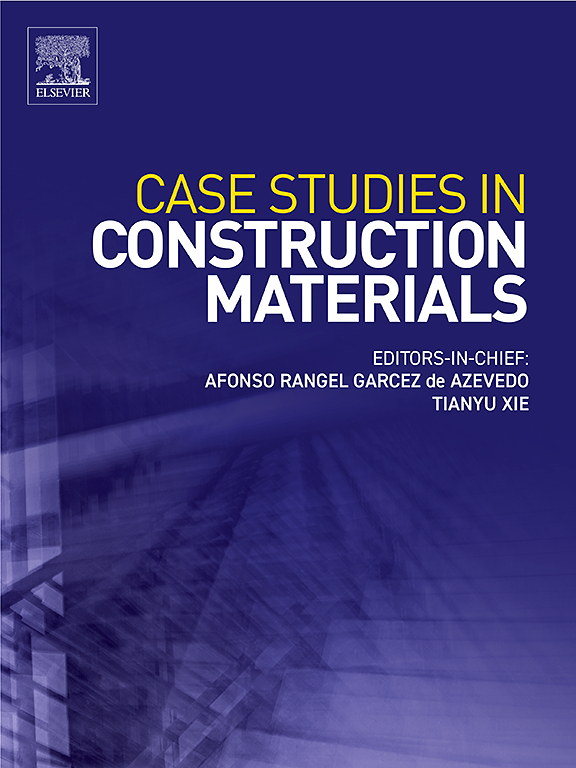低碳碱活化材料稳定Cu(II)污染土壤:反应动力学、固定机制和浸出行为
IF 6.6
2区 工程技术
Q1 CONSTRUCTION & BUILDING TECHNOLOGY
引用次数: 0
摘要
碱活化胶凝材料(AAMs)是公认的低碳粘结剂,在固化/稳定化(S/S)领域具有相当大的潜力。本研究旨在探讨Cu2 +对AAMs反应动力学和产物的影响,并考察Cu2+在反应产物中的固定机制。结果表明,AAMs的早期反应动力学仅受Cu2+掺入的轻微影响,表明AAMs与Cu2+具有较强的相容性。碱当量的增加促进了反应产物的形成,优化了AAMs的孔结构,显著提高了AAMs的抗压强度和Cu2+包封效率。然而,Cu2+的掺入增加了大孔隙的含量,使AAMs的力学性能恶化。值得注意的是,Cu2+在非晶相中与硅四面体形成共价键,导致C/N-A-S-H的MCL增加。此外,Cu2+可以通过离子取代和阴离子键合在非晶凝胶中实现化学固定。实际S/S分析结果表明,当土壤Cu含量为 % 70时,28 d后S/S块体中Cu的浸出浓度低至0.61 mg/L,抗压强度为8.9 MPa。与普通波特兰水泥(OPC)相比,利用AAMs进行铜污染土壤的S/S处理可减少58.5% %的碳排放。总体而言,本研究肯定了AAMs作为一种可行的低碳S/S处理替代方案,为重金属污染土壤的治理提供了可持续和经济的选择。本文章由计算机程序翻译,如有差异,请以英文原文为准。
Low-carbon alkali-activated materials for Cu(II)-contaminated soil stabilization: Reaction kinetics, immobilization mechanisms, and leaching behavior
Alkali-activated cementitious materials (AAMs) are recognized as low-carbon binders with considerable potential in the solidification/stabilization (S/S) field. This study aimed to explore the influence of Cu2 + on the reaction kinetics and products of AAMs and examined the immobilization mechanisms of Cu2+ within the reaction products. Results indicated that the early reaction kinetics of AAMs was only slightly impacted by the incorporation of Cu2+, showing a strong compatibility between the AAMs and Cu2+. The addition of an increased alkali equivalent facilitated the formation of reaction products, optimized the pore structure of AAMs, and significantly improved the compressive strength and Cu2+ encapsulation efficiency. However, incorporating Cu2+ increased the content of large pores, which deteriorated the mechanical properties of AAMs. Notably, Cu2+ chemically bonded in the amorphous phase by forming covalent bonds with silicon tetrahedra, which resulted in an increase in the MCL of C/N-A-S-H. Moreover, Cu2+ could achieve chemical immobilization in the amorphous gel by ion substitution and bonding to anionic sites. Actual S/S analysis revealed that with 70 % Cu-contaminated soil, the leaching concentration of Cu in S/S blocks was as low as 0.61 mg/L, with a compressive strength of 8.9 MPa after 28 days. Compared to ordinary Portland cement (OPC), utilizing AAMs for S/S treatment of Cu-contaminated soil reduced carbon emissions by 58.5 %. Overall, this research affirmed AAMs as a viable low-carbon alternative for S/S treatments, providing a sustainable and economical option for the management of heavy metal-contaminated soils.
求助全文
通过发布文献求助,成功后即可免费获取论文全文。
去求助
来源期刊

Case Studies in Construction Materials
Multiple-
CiteScore
7.60
自引率
19.40%
发文量
842
审稿时长
63 days
期刊介绍:
Case Studies in Construction Materials provides a forum for the rapid publication of short, structured Case Studies on construction materials. In addition, the journal also publishes related Short Communications, Full length research article and Comprehensive review papers (by invitation).
The journal will provide an essential compendium of case studies for practicing engineers, designers, researchers and other practitioners who are interested in all aspects construction materials. The journal will publish new and novel case studies, but will also provide a forum for the publication of high quality descriptions of classic construction material problems and solutions.
 求助内容:
求助内容: 应助结果提醒方式:
应助结果提醒方式:


